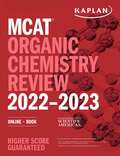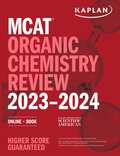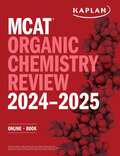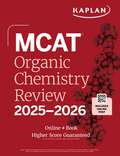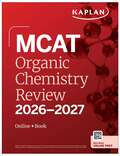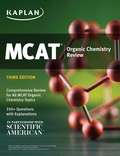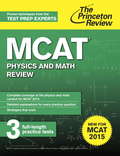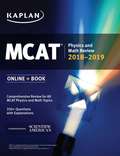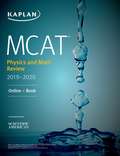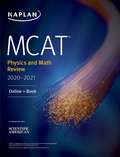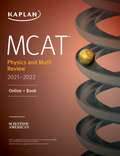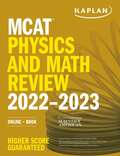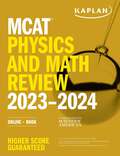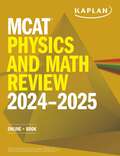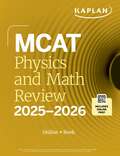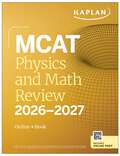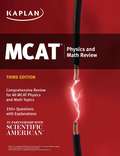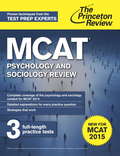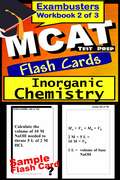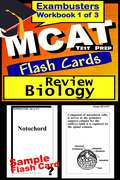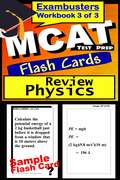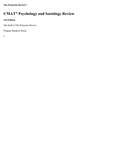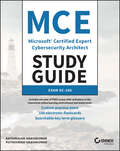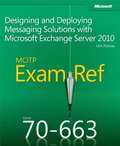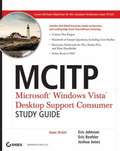- Table View
- List View
MCAT Organic Chemistry Review 2022-2023: Online + Book (Kaplan Test Prep)
by Kaplan Test PrepKaplan&’s MCAT Organic Chemistry Review 2022–2023 offers an expert study plan, detailed subject review, and hundreds of online and in-book practice questions—all authored by the experts behind the MCAT prep course that has helped more people get into medical school than all other major courses combined. Prepping for the MCAT is a true challenge. Kaplan can be your partner along the way—offering guidance on where to focus your efforts and how to organize your review. This book has been updated to match the AAMC&’s guidelines precisely—no more worrying about whether your MCAT review is comprehensive!The Most PracticeMore than 350 questions in the book and access to even more online—more practice than any other MCAT organic chemistry book on the market.The Best PracticeComprehensive organic chemistry subject review is written by top-rated, award-winning Kaplan instructors.Full-color, 3-D illustrations from Scientific American, charts, graphs and diagrams help turn even the most complex science into easy-to-visualize concepts.All material is vetted by editors with advanced science degrees and by a medical doctor.Online resources, including a full-length practice test, help you practice in the same computer-based format you&’ll see on Test Day.Expert GuidanceHigh-yield badges throughout the book identify the top 100 topics most tested by the AAMC.We know the test: The Kaplan MCAT team has spent years studying every MCAT-related document available. Kaplan&’s expert psychometricians ensure our practice questions and study materials are true to the test.
MCAT Organic Chemistry Review 2023-2024: Online + Book (Kaplan Test Prep)
by Kaplan Test PrepKaplan&’s MCAT Organic Chemistry Review 2023–2024 offers an expert study plan, detailed subject review, and hundreds of online and in-book practice questions—all authored by the experts behind the MCAT prep course that has helped more people get into medical school than all other major courses combined.Prepping for the MCAT is a true challenge. Kaplan can be your partner along the way—offering guidance on where to focus your efforts and how to organize your review. This book has been updated to match the AAMC&’s guidelines precisely—no more worrying about whether your MCAT review is comprehensive!The Most PracticeMore than 350 questions in the book and access to even more online—more practice than any other MCAT organic chemistry book on the market.The Best PracticeComprehensive organic chemistry subject review is written by top-rated, award-winning Kaplan instructors.Full-color, 3-D illustrations from Scientific American, charts, graphs and diagrams help turn even the most complex science into easy-to-visualize concepts.All material is vetted by editors with advanced science degrees and by a medical doctor.Online resources, including a full-length practice test, help you practice in the same computer-based format you&’ll see on Test Day.Expert GuidanceHigh-yield badges throughout the book identify the topics most frequently tested by the AAMC.We know the test: The Kaplan MCAT team has spent years studying every MCAT-related document available. Kaplan&’s expert psychometricians ensure our practice questions and study materials are true to the test.
MCAT Organic Chemistry Review 2024-2025: Online + Book (Kaplan Test Prep)
by Kaplan Test PrepKaplan&’s MCAT Organic Chemistry Review 2024-2025 offers an expert study plan, detailed subject review, and hundreds of online and in-book practice questions—all authored by the experts behind the MCAT prep course that has helped more people get into medical school than all other major courses combined.Prepping for the MCAT is a true challenge. Kaplan can be your partner along the way—offering guidance on where to focus your efforts and how to organize your review. This book has been updated to match the AAMC&’s guidelines precisely—no more worrying about whether your MCAT review is comprehensive!The Most PracticeMore than 350 questions in the book and access to even more online—more practice than any other MCAT organic chemistry book on the market.The Best PracticeComprehensive organic chemistry subject review is written by top-rated, award-winning Kaplan instructors.Full-color, 3-D illustrations, charts, graphs and diagrams help turn even the most complex science into easy-to-visualize concepts.All material is vetted by editors with advanced science degrees and by a medical doctor.Online resources, including a full-length practice test, help you practice in the same computer-based format you&’ll see on Test Day.Expert GuidanceHigh-yield badges throughout the book identify the topics most frequently tested by the AAMC.We know the test: The Kaplan MCAT team has spent years studying every MCAT-related document available. Kaplan&’s expert psychometricians ensure our practice questions and study materials are true to the test.
MCAT Organic Chemistry Review 2025-2026: Online + Book (Kaplan Test Prep)
by Kaplan Test PrepKaplan&’s MCAT Organic Chemistry Review 2024-2025 offers an expert study plan, detailed subject review, and hundreds of online and in-book practice questions—all authored by the experts behind the MCAT prep course that has helped more people get into medical school than all other major courses combined.Prepping for the MCAT is a true challenge. Kaplan can be your partner along the way—offering guidance on where to focus your efforts and how to organize your review. This book has been updated to match the AAMC&’s guidelines precisely—no more worrying about whether your MCAT review is comprehensive!The Most PracticeMore than 350 questions in the book and access to even more online—more practice than any other MCAT organic chemistry book on the market.The Best PracticeComprehensive organic chemistry subject review is written by top-rated, award-winning Kaplan instructors.Full-color, 3-D illustrations, charts, graphs and diagrams help turn even the most complex science into easy-to-visualize concepts.All material is vetted by editors with advanced science degrees and by a medical doctor.Online resources, including a full-length practice test, help you practice in the same computer-based format you&’ll see on Test Day.Expert GuidanceHigh-yield badges throughout the book identify the topics most frequently tested by the AAMC.We know the test: The Kaplan MCAT team has spent years studying every MCAT-related document available. Kaplan&’s expert psychometricians ensure our practice questions and study materials are true to the test.
MCAT Organic Chemistry Review 2026-2027: Online + Book (Kaplan Test Prep)
by Kaplan Test PrepKaplan&’s MCAT Organic Chemistry Review 2026-2027 offers an expert study plan, detailed subject review, and hundreds of online and in-book practice questions—all authored by the experts behind Kaplan's score-raising MCAT prep course. Prepping for the MCAT is a true challenge. Kaplan can be your partner along the way—offering guidance on where to focus your efforts and how to organize your review. This book has been updated to match the AAMC&’s guidelines precisely—no more worrying about whether your MCAT review is comprehensive!The Most Practice More than 350 questions in the book and access to even more online—more practice than any other MCAT organic chemistry book on the market. The Best Practice Comprehensive organic chemistry subject review is written by top-rated, award-winning Kaplan instructors. Full-color, 3-D illustrations, charts, graphs and diagrams help turn even the most complex science into easy-to-visualize concepts. All material is vetted by editors with advanced science degrees and by a medical doctor. Online resources, including a full-length practice test, help you practice in the same computer-based format you&’ll see on Test Day. Expert Guidance High-yield badges throughout the book identify the topics most frequently tested by the AAMC. We know the test: The Kaplan MCAT team has spent years studying every MCAT-related document available. Kaplan&’s expert psychometricians ensure our practice questions and study materials are true to the test.
MCAT Organic Chemistry Review: Online + Book
by KaplanMore people get into medical school with a Kaplan MCAT course than all major courses combined. Now the same results are available with MCAT Organic Chemistry Review. This book features thorough subject review, more questions than any competitor, and the highest-yield questions available. The commentary and instruction come directly from Kaplan MCAT experts and include targeted focus on the most-tested concepts.MCAT Organic Chemistry Review offers:UNPARALLELED MCAT KNOWLEDGE: The Kaplan MCAT team has spent years studying every MCAT-related document available. In conjunction with our expert psychometricians, the Kaplan team is able to ensure the accuracy and realism of our practice materials.THOROUGH SUBJECT REVIEW: Written by top-rated, award-winning Kaplan instructors, all material has been vetted by editors with advanced science degrees and by a medical doctor.EXPANDED CONTENT THROUGHOUT: As the MCAT has continued to develop, this book has been updated continuously to match the AAMC's guidelines precisely--no more worrying if your prep is comprehensive!"STAR RATINGS" FOR EVERY SUBJECT: New for the 3rd Edition of MCAT Organic Chemistry Review, every topic in every chapter is assigned a "star rating"--informed by Kaplan's decades of MCAT experience and facts straight from the testmaker--of how important it will be to your score on the real exam.MORE PRACTICE THAN THE COMPETITION: With questions throughout the book and access to a full-length practice test online, MCAT Organic Chemistry Review has more practice than any other MCAT organic chemistry book on the market.ONLINE COMPANION: One practice test and additional online resources help augment content studying. The MCAT is a computer-based test, so practicing in the same format as Test Day is key.TOP-QUALITY IMAGES: With full-color, 3-D illustrations, charts, graphs and diagrams from the pages of Scientific American, MCAT Organic Chemistry Review turns even the most intangible, complex science into easy-to-visualize concepts.KAPLAN'S MCAT REPUTATION: Kaplan is a leader in the MCAT prep market, and twice as many doctors prepared for the MCAT with Kaplan than with any other course.*UTILITY: Can be used alone or with the other companion books in Kaplan's MCAT Review series. * Doctors refers to US MDs who were licensed between 2001-2010 and used a fee-based course to prepare for the MCAT. The AlphaDetail, Inc. online study for Kaplan was conducted between Nov. 10 - Dec. 9, 2010 among 763 US licensed MDs, of whom 462 took the MCAT and used a fee-based course to prepare for it.
MCAT Physics and Math Review
by Princeton ReviewPublisher's Note: This eBook contains detailed color diagrams and art and is best viewed on tablets or other color-capable devices with zooming ability. We do not recommend this title for black-and-white E Ink devices.Get everything you need to ace the Physics and Math material on the new MCAT exam! Designed specifically for students taking the longer, tougher exam debuting in 2015, The Princeton Review's MCAT PHYSICS AND MATH REVIEW features:Everything You Need to Know to Help Achieve a High Score:· Access to our online Student Tools portal for up-to-the-moment information on late-breaking AAMC changes to the exam· In-depth coverage of the challenging physics and math topics on this important test · Bulleted summary sheets of physics formulas and constants for quick review · Full-color illustrations, diagrams, and tables· An extensive glossary for handy reference· Strategic guidance and effective test-taking techniquesMore Practice Than Ever:· 3 full-length practice tests online· End-of-chapter practice questions· MCAT-style practice passages· Detailed answer explanations for every practice questionIn MCAT PHYSICS AND MATH REVIEW, you'll gain mastery of topics like:· MCAT 2015 Basics· Kinematics· Mechanics· Fluids and Elasticity of Solids· Electrostatics· Electricity and Magnetism· Oscillations and Waves· Sound· Light and Geometrical OpticsAnd more!
MCAT Physics and Math Review 2018-2019: Online + Book
by Kaplan Test PrepKaplan's MCAT Physics and Math Review 2018-2019 offers an expert study plan, detailed subject review, and hundreds of online and in-book practice questions – all authored by the experts behind the MCAT prep course that has helped more people get into medical school than all other major courses combined.Prepping for the MCAT is a true challenge. Kaplan can be your partner along the way – offering guidance on where to focus your efforts and how to organize your review. With the most recent changes to the MCAT, physics and math is one of the most high-yield areas for study. This book has been updated to match the AAMC's guidelines precisely—no more worrying if your MCAT review is comprehensive!The Most PracticeMore than 350 questions in the book and access to even more online – more practice than any other MCAT physics and math book on the market.The Best PracticeComprehensive physics and math subject review is written by top-rated, award-winning Kaplan instructors.Full-color, 3-D illustrations from Scientific American, charts, graphs and diagrams help turn even the most complex science into easy-to-visualize concepts.All material is vetted by editors with advanced science degrees and by a medical doctor.Online resources help you practice in the same computer-based format you'll see on Test Day.Expert GuidanceHigh-yield badges throughout the book identify the top 100 topics most-tested by the AAMC.We know the test: The Kaplan MCAT team has spent years studying every MCAT-related document available.Kaplan's expert psychometricians ensure our practice questions and study materials are true to the test.
MCAT Physics and Math Review 2019-2020: Online + Book (Kaplan Test Prep)
by Kaplan Test PrepA Simon & Schuster eBook. Simon & Schuster has a great book for every reader.
MCAT Physics and Math Review 2020-2021: Online + Book (Kaplan Test Prep)
by Kaplan Test PrepKaplan’s MCAT Physics and Math Review 2020-2021 is updated to reflect the latest, most accurate, and most testable materials on the MCAT. A new layout makes our book even more streamlined and intuitive for easier review.You’ll get efficient strategies, detailed subject review, and hundreds of practice questions—all authored by the experts behind the MCAT prep course that has helped more people get into medical school than all other major courses combined.Efficient Strategies and In-Depth ReviewHigh Yield badges indicate the most testable content based on AAMC materialsConcept summaries that boil down the need-to-know information in each chapter, including any necessary equations to memorizeChapter Profiles indicate the degree to which each chapter is tested and the testmaker content categories to which it alignsCharts, graphs, diagrams, and full-color, 3-D illustrations from Scientific American help turn even the most complex science into easy-to-visualize conceptsRealistic PracticeOne-year online access to instructional videos, practice questions, and quizzesHundreds of practice questions show you how to apply concepts and equations15 multiple-choice “Test Your Knowledge” questions at the end of each chapterLearning objectives and concept checks ensure you’re focusing on the most important information in each chapterExpert GuidanceSidebars illustrate connections between concepts and include references to more information, real-world tie ins, mnemonics, and MCAT-specific tipsComprehensive subject review written by top-rated, award-winning Kaplan instructors who guide you on where to focus your efforts and how to organize your review.All material is vetted by editors with advanced science degrees and by a medical doctor.We know the test: The Kaplan MCAT team has spent years studying every MCAT-related document available, and our experts ensure our practice questions and study materials are true to the test
MCAT Physics and Math Review 2021-2022: Online + Book (Kaplan Test Prep)
by Kaplan Test PrepKaplan&’s MCAT Physics and Math Review 2020-2021 offers an expert study plan, detailed subject review, and hundreds of online and in-book practice questions—all authored by the experts behind the MCAT prep course that has helped more people get into medical school than all other major courses combined.Prepping for the MCAT is a true challenge. Kaplan can be your partner along the way—offering guidance on where to focus your efforts and how to organize your review. This book has been updated to match the AAMC&’s guidelines precisely—no more worrying if your MCAT review is comprehensive!The Most PracticeMore than 350 questions in the book and access to even more online—more practice than any other MCAT physics and math book on the market.The Best PracticeComprehensive physics and math subject review is written by top-rated, award-winning Kaplan instructors.Full-color, 3-D illustrations from Scientific American, charts, graphs and diagrams help turn even the most complex science into easy-to-visualize conceptsAll material is vetted by editors with advanced science degrees and by a medical doctor.Online resources, including a full-length practice test, help you practice in the same computer-based format you&’ll see on Test Day.Expert GuidanceHigh-yield badges throughout the book identify the top 100 topics most-tested by the AAMC.We know the test: The Kaplan MCAT team has spent years studying every MCAT-related document available.Kaplan&’s expert psychometricians ensure our practice questions and study materials are true to the test.
MCAT Physics and Math Review 2022-2023: Online + Book (Kaplan Test Prep)
by Kaplan Test PrepKaplan&’s MCAT Physics and Math Review 2022–2023 offers an expert study plan, detailed subject review, and hundreds of online and in-book practice questions—all authored by the experts behind the MCAT prep course that has helped more people get into medical school than all other major courses combined. Prepping for the MCAT is a true challenge. Kaplan can be your partner along the way—offering guidance on where to focus your efforts and how to organize your review. This book has been updated to match the AAMC&’s guidelines precisely—no more worrying about whether your MCAT review is comprehensive!The Most PracticeMore than 350 questions in the book and access to even more online—more practice than any other MCAT physics and math book on the market.The Best PracticeComprehensive physics and math subject review is written by top-rated, award-winning Kaplan instructors.Full-color, 3-D illustrations from Scientific American, charts, graphs and diagrams help turn even the most complex science into easy-to-visualize concepts.All material is vetted by editors with advanced science degrees and by a medical doctor.Online resources, including a full-length practice test, help you practice in the same computer-based format you&’ll see on Test Day.Expert GuidanceHigh-yield badges throughout the book identify the top 100 topics most tested by the AAMC.We know the test: The Kaplan MCAT team has spent years studying every MCAT-related document available. Kaplan&’s expert psychometricians ensure our practice questions and study materials are true to the test.
MCAT Physics and Math Review 2023-2024: Online + Book (Kaplan Test Prep)
by Kaplan Test PrepKaplan&’s MCAT Physics and Math Review 2023–2024 offers an expert study plan, detailed subject review, and hundreds of online and in-book practice questions—all authored by the experts behind the MCAT prep course that has helped more people get into medical school than all other major courses combined.Prepping for the MCAT is a true challenge. Kaplan can be your partner along the way—offering guidance on where to focus your efforts and how to organize your review. This book has been updated to match the AAMC&’s guidelines precisely—no more worrying about whether your MCAT review is comprehensive!The Most PracticeMore than 350 questions in the book and access to even more online—more practice than any other MCAT physics and math book on the market.The Best PracticeComprehensive physics and math subject review is written by top-rated, award-winning Kaplan instructors.Full-color, 3-D illustrations from Scientific American, charts, graphs and diagrams help turn even the most complex science into easy-to-visualize concepts.All material is vetted by editors with advanced science degrees and by a medical doctor.Online resources, including a full-length practice test, help you practice in the same computer-based format you&’ll see on Test Day.Expert GuidanceHigh-yield badges throughout the book identify the topics most frequently tested by the AAMC.We know the test: The Kaplan MCAT team has spent years studying every MCAT-related document available. Kaplan&’s expert psychometricians ensure our practice questions and study materials are true to the test.
MCAT Physics and Math Review 2024-2025: Online + Book (Kaplan Test Prep)
by Kaplan Test PrepKaplan&’s MCAT Physics and Math Review 2024-2025 offers an expert study plan, detailed subject review, and hundreds of online and in-book practice questions—all authored by the experts behind the MCAT prep course that has helped more people get into medical school than all other major courses combined.Prepping for the MCAT is a true challenge. Kaplan can be your partner along the way—offering guidance on where to focus your efforts and how to organize your review. This book has been updated to match the AAMC&’s guidelines precisely—no more worrying about whether your MCAT review is comprehensive!The Most PracticeMore than 350 questions in the book and access to even more online—more practice than any other MCAT physics and math book on the market.The Best PracticeComprehensive physics and math subject review is written by top-rated, award-winning Kaplan instructors.Full-color, 3-D illustrations, charts, graphs and diagrams help turn even the most complex science into easy-to-visualize concepts.All material is vetted by editors with advanced science degrees and by a medical doctor.Online resources, including a full-length practice test, help you practice in the same computer-based format you&’ll see on Test Day.Expert GuidanceHigh-yield badges throughout the book identify the topics most frequently tested by the AAMC.We know the test: The Kaplan MCAT team has spent years studying every MCAT-related document available. Kaplan&’s expert psychometricians ensure our practice questions and study materials are true to the test.
MCAT Physics and Math Review 2025-2026: Online + Book (Kaplan Test Prep)
by Kaplan Test PrepKaplan&’s MCAT Physics and Math Review 2024-2025 offers an expert study plan, detailed subject review, and hundreds of online and in-book practice questions—all authored by the experts behind the MCAT prep course that has helped more people get into medical school than all other major courses combined.Prepping for the MCAT is a true challenge. Kaplan can be your partner along the way—offering guidance on where to focus your efforts and how to organize your review. This book has been updated to match the AAMC&’s guidelines precisely—no more worrying about whether your MCAT review is comprehensive!The Most PracticeMore than 350 questions in the book and access to even more online—more practice than any other MCAT physics and math book on the market.The Best PracticeComprehensive physics and math subject review is written by top-rated, award-winning Kaplan instructors.Full-color, 3-D illustrations, charts, graphs and diagrams help turn even the most complex science into easy-to-visualize concepts.All material is vetted by editors with advanced science degrees and by a medical doctor.Online resources, including a full-length practice test, help you practice in the same computer-based format you&’ll see on Test Day.Expert GuidanceHigh-yield badges throughout the book identify the topics most frequently tested by the AAMC.We know the test: The Kaplan MCAT team has spent years studying every MCAT-related document available. Kaplan&’s expert psychometricians ensure our practice questions and study materials are true to the test.
MCAT Physics and Math Review 2026-2027: Online + Book (Kaplan Test Prep)
by Kaplan Test PrepKaplan&’s MCAT Physics and Math Review 2026-2027 offers an expert study plan, detailed subject review, and hundreds of online and in-book practice questions—all authored by the experts behind Kaplan's score-raising MCAT prep course. Prepping for the MCAT is a true challenge. Kaplan can be your partner along the way—offering guidance on where to focus your efforts and how to organize your review. This book has been updated to match the AAMC&’s guidelines precisely—no more worrying about whether your MCAT review is comprehensive!The Most Practice More than 350 questions in the book and access to even more online—more practice than any other MCAT physics and math book on the market. The Best Practice Comprehensive physics and math subject review is written by top-rated, award-winning Kaplan instructors. Full-color, 3-D illustrations, charts, graphs and diagrams help turn even the most complex science into easy-to-visualize concepts. All material is vetted by editors with advanced science degrees and by a medical doctor. Online resources, including a full-length practice test, help you practice in the same computer-based format you&’ll see on Test Day. Expert Guidance High-yield badges throughout the book identify the topics most frequently tested by the AAMC. We know the test: The Kaplan MCAT team has spent years studying every MCAT-related document available. Kaplan&’s expert psychometricians ensure our practice questions and study materials are true to the test.
MCAT Physics and Math Review: Online + Book
by KaplanMore people get into medical school with a Kaplan MCAT course than all major courses combined. Now the same results are available with MCAT Physics and Math Review. This book features thorough subject review, more questions than any competitor, and the highest-yield questions available. The commentary and instruction come directly from Kaplan MCAT experts and include targeted focus on the most-tested concepts.MCAT Physics and Math Review offers:UNPARALLELED MCAT KNOWLEDGE: The Kaplan MCAT team has spent years studying every MCAT-related document available. In conjunction with our expert psychometricians, the Kaplan team is able to ensure the accuracy and realism of our practice materials.THOROUGH SUBJECT REVIEW: Written by top-rated, award-winning Kaplan instructors, all material has been vetted by editors with advanced science degrees and by a medical doctor.EXPANDED CONTENT THROUGHOUT: While the MCAT has continued to develop, this book has been updated continuously to match the AAMC's guidelines precisely--no more worrying if your prep is comprehensive!"STAR RATINGS" FOR EVERY SUBJECT: New for the 3rd Edition of MCAT Physics and Math Review, every topic in every chapter is assigned a "star rating"--informed by Kaplan's decades of MCAT experience and facts straight from the testmaker--of how important it will be to your score on the real exam.MORE PRACTICE THAN THE COMPETITION: With 350+ questions throughout the book and access to a full-length practice test online, MCAT Physics and Math Review has more practice than any other MCAT physics and math book on the market.ONLINE COMPANION: One practice test and additional online resources help augment content studying. The MCAT is a computer-based test, so practicing in the same format as Test Day is key.TOP-QUALITY IMAGES: With full-color, 3-D illustrations, charts, graphs and diagrams from the pages of Scientific American, MCAT Physics and Math Review turns even the most intangible, complex science into easy-to-visualize concepts.KAPLAN'S MCAT REPUTATION: Kaplan is a leader in the MCAT prep market, and twice as many doctors prepared for the MCAT with Kaplan than with any other course.*UTILITY: Can be used alone or with the other companion books in Kaplan's MCAT Review series.* Doctors refers to US MDs who were licensed between 2001-2010 and used a fee-based course to prepare for the MCAT. The AlphaDetail, Inc. online study for Kaplan was conducted between Nov. 10 - Dec. 9, 2010 among 763 US licensed MDs, of whom 462 took the MCAT and used a fee-based course to prepare for it.
MCAT Psychology and Sociology Review
by Princeton ReviewPublisher's Note: This eBook contains detailed color diagrams and art and is best viewed on tablets or other color-capable devices with zooming ability. We do not recommend this title for black-and-white E Ink devices. Get everything you need to ace the new Psychological, Social, and Biological Foundations of Behavior section on the updated MCAT exam! Designed specifically for students taking the longer, tougher exam debuting in 2015, The Princeton Review's MCAT PSYCHOLOGY AND SOCIOLOGY REVIEW features:Everything You Need to Know to Help Achieve a High Score:· Access to our online Student Tools portal for up-to-the-moment information on late-breaking AAMC changes to the exam· In-depth coverage of the challenging psychology and sociology topics on the brand-new Psychological, Social, and Biological Foundations of Behavior section · Bulleted chapter summaries for quick review · Full-color illustrations, diagrams, and tables· An extensive glossary for handy reference· Strategic guidance and effective test-taking techniquesMore Practice Than Ever:· 3 full-length practice tests online· End-of-chapter practice questions· MCAT-style practice passagesIn MCAT PSYCHOLOGY AND SOCIOLOGY REVIEW, you'll gain mastery of topics like:· MCAT 2015 Basics· Biological Foundations of Behavior· Interacting with the Environment· Personality, Motivation, Attitudes, and Psychological Disorders· Self-Identity and Group Identity· Social Structure· Psychology and Sociology Strategy for the MCAT· Learning, Memory, and Behavior· Statistics and Research MethodsAnd more!
MCAT Test Prep Flash Cards: Inorganic Chemistry (Exambusters MCAT Workbook #2 of 3)
by Ace Inc.<P><P><i>Advisory: Bookshare has learned that this book offers only partial accessibility. We have kept it in the collection because it is useful for some of our members. Benetech is actively working on projects to improve accessibility issues such as these.</i><P><P> 700 questions and answers. Essential chemistry formulas and concepts you need. <P><P>Topics: Metric System, Matter, Atoms, Formulas, Moles, Reactions, Elements, Chemical Bonds, Phase Changes, Solutions, Reaction Rates, Acids and Bases, Oxidation and Reduction, Introduction to Organic <P>EXAMBUSTERS MCAT Prep Workbooks provide comprehensive, fundamental MCAT review--one fact at a time--to prepare students to take practice MCAT tests. Each MCAT study guide focuses on one specific subject area covered on the MCAT exam. From 300 to 600 questions and answers, each volume in the MCAT series is a quick and easy, focused read. Reviewing MCAT flash cards is the first step toward more confident MCAT preparation and ultimately, higher MCAT exam scores!
MCAT Test Prep Flash Cards: Review Biology (Exambusters MCAT Workbook #1 of 3)
by Ace Inc.<P><P><i>Advisory: Bookshare has learned that this book offers only partial accessibility. We have kept it in the collection because it is useful for some of our members. Benetech is actively working on projects to improve accessibility issues such as these.</i><P><P> 450 questions and answers. <P><P>Topics: Cells, Biochemistry and Energy, Evolution, Kingdoms: Monera, Fungi, Protista, Plants, Animals; Human: Locomotion, Circulation, Immunology, Respiration, Excretion, Digestion, Nervous System <P>EXAMBUSTERS MCAT Prep Workbooks provide comprehensive, fundamental MCAT review--one fact at a time--to prepare students to take practice MCAT tests. Each MCAT study guide focuses on one specific subject area covered on the MCAT exam. From 300 to 600 questions and answers, each volume in the MCAT series is a quick and easy, focused read. Reviewing MCAT flash cards is the first step toward more confident MCAT preparation and ultimately, higher MCAT exam scores!
MCAT Test Prep Flash Cards: Review Physics (Exambusters MCAT Workbook #3 of 3)
by Ace Inc.<P><P><i>Advisory: Bookshare has learned that this book offers only partial accessibility. We have kept it in the collection because it is useful for some of our members. Benetech is actively working on projects to improve accessibility issues such as these.</i><P><P> 600 questions and answers. Sample problems. <P><P>Topics: Metric System, Motion and Forces, Work and Energy, Fluids, Sound, Light and Optics, Static Electricity, D.C. and A.C. Circuits, Magnetism <P>EXAMBUSTERS MCAT Prep Workbooks provide comprehensive, fundamental MCAT review--one fact at a time--to prepare students to take practice MCAT tests. Each MCAT study guide focuses on one specific subject area covered on the MCAT exam. From 300 to 600 questions and answers, each volume in the MCAT series is a quick and easy, focused read. Reviewing MCAT flash cards is the first step toward more confident MCAT preparation and ultimately, higher MCAT exam scores!
MCAT® Psychology and Sociology Review (Graduate School Test Preparation)
by Princeton StaffIF IT'S ON THE TEST, IT'S IN THIS BOOK. The Princeton Review's MCAT Psychology and Sociology Review brings you everything you need to ace the Behavioral Sciences concepts on the MCAT, including a thorough content review and 3 full-length practice tests. Everything You Need to Know to Help Achieve a High Score. - In-depth coverage of the challenging psych/soc topics on this important test - Full-color illustrations, diagrams, and tables - Extensive glossary for handy reference - Bulleted chapter summaries for quick review
MCE Microsoft Certified Expert Cybersecurity Architect Study Guide: Exam SC-100
by Puthiyavan Udayakumar Kathiravan UdayakumarPrep for the SC-100 exam like a pro with Sybex’ latest Study Guide In the MCE Microsoft Certified Expert Cybersecurity Architect Study Guide: Exam SC-100, a team of dedicated software architects delivers an authoritative and easy-to-follow guide to preparing for the SC-100 Cybersecurity Architect certification exam offered by Microsoft. In the book, you’ll find comprehensive coverage of the objectives tested by the exam, covering the evaluation of Governance Risk Compliance technical and security operations strategies, the design of Zero Trust strategies and architectures, and data and application strategy design. With the information provided by the authors, you’ll be prepared for your first day in a new role as a cybersecurity architect, gaining practical, hands-on skills with modern Azure deployments. You’ll also find: In-depth discussions of every single objective covered by the SC-100 exam and, by extension, the skills necessary to succeed as a Microsoft cybersecurity architect Critical information to help you obtain a widely sought-after credential that is increasingly popular across the industry (especially in government roles) Valuable online study tools, including hundreds of bonus practice exam questions, electronic flashcards, and a searchable glossary of crucial technical termsAn essential roadmap to the SC-100 exam and a new career in cybersecurity architecture on the Microsoft Azure cloud platform, MCE Microsoft Certified Expert Cybersecurity Architect Study Guide: Exam SC-100 is also ideal for anyone seeking to improve their knowledge and understanding of cloud-based management and security.
MCITP 70-663 Exam Ref: Designing and Deploying Messaging Solutions with Microsoft® Exchange Server 2010
by Orin ThomasProfessional-level prep for the professional-level exam. Prepare for MCITP Exam 70-663--and help demonstrate your real-world mastery of enterprise messaging administration with Microsoft Exchange Server. Designed for experienced, MCTS-certified professionals ready to advance their status--Exam Ref focuses on the critical-thinking and decision-making acumen needed for success at the MCITP level. Focus on the expertise measured by these objectives: Planning the Exchange Server 2010 Infrastructure Deploying the Exchange Server 2010 Infrastructure Designing and Deploying Security for the Exchange Organization Designing and Deploying Exchange Server 2010 Availability and Recovery Designing and Deploying Messaging Compliance, System Monitoring, and Reporting
MCITP Microsoft Windows Vista Desktop Support Consumer: Study Guide (70-623)
by Eric Johnson Eric BeehlerThis comprehensive guide takes readers through Microsoft's new certification, MCITP, and offers them the skills required to pass the Microsoft 70-623 exam on supporting and troubleshooting applications.
